6 Sub-Saharan Africa
Learning Objectives
- Identify the key geographic features of Sub-Saharan Africa
- Describe the pre-colonial history of Sub-Saharan Africa
- Explain the process of colonization in Sub-Saharan Africa and its effects on the modern geographic landscape
- Analyze how colonization has impacted political stability and economic opportunity across Sub-Saharan Africa
6.1 The Physical Landscape of Sub-Saharan Africa
Africa is the cradle of human civilization. Our early ancestors, homo erectus, meaning “upright man,” first walked in East Africa between one and two million years ago. Early humans in Africa were the first to create tools, develop language, and control fire. The physical landscape of Africa and its long history of habitation have contributed to a variety of cultures and human experiences.
Africa is the second-largest continent after Asia and is the only continent that is crossed by both the Tropic of Cancer, located 23 degrees north of the Equator, and the Tropic of Capricorn, located 23 degrees south of the Equator (see Figure 6.1). These tropics are areas of high atmospheric pressure creating dry conditions. The Sahara lies along the Tropic of Cancer in the north and the Namib Desert is situated on the Tropic of Capricorn in the south. The Sahara stretches across much of northern Africa creating a formidable barrier and dividing Africa between a Muslim, Arab North and traditional African cultural groups in the south. Since North Africa is so similar to Southwest Asia in terms of culture and political history, the two are discussed together in a separate chapter.
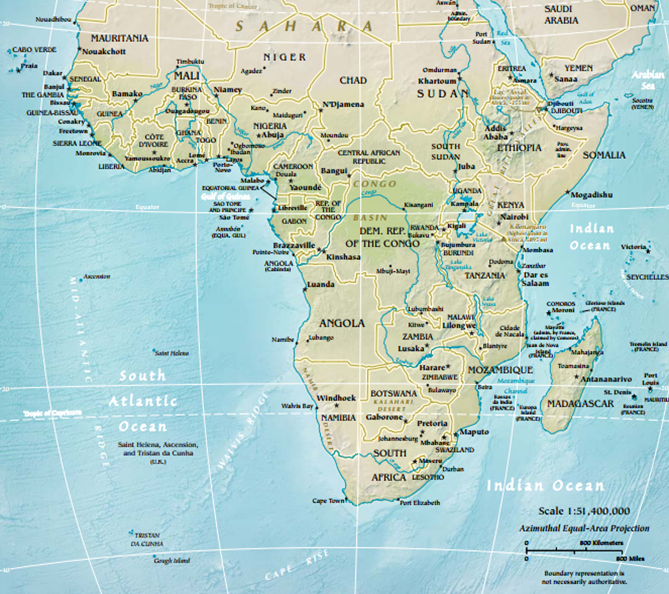
The story of Africa’s physical geography begins 300 million years ago with the landmass known as Pangaea, the last supercontinent (see Figure 6.2). Around 175 million years ago, Pangaea began to break apart, drifting and colliding and forming the continents as we know them today. Africa was situated at the heart of this supercontinent.
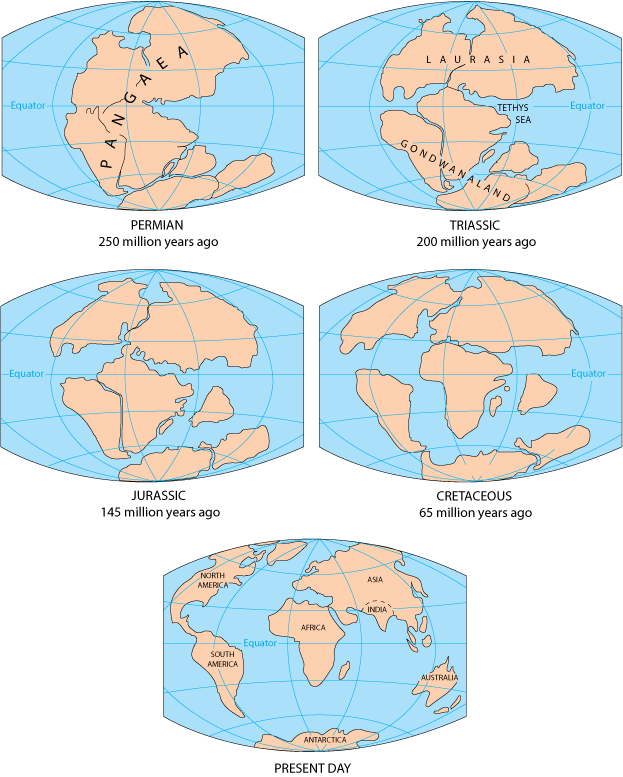
Today, many of the physical landforms found in Africa were formed from this tectonic plate movement. Africa’s Great Rift Valley, for example, is slowly splitting away from the rest of the African Plate at a rate of around 6 to 7 mm (around 0.25 in) each year (see Figure 6.3). That might not sound like a lot, but after 100 years, the rift would have expanded by two feet! Some of the deepest lakes in the world are found along this rift valley, where huge cracks in the earth’s surface have filled with water over time. Lake Tanganyika, for example, is the second-largest and second-deepest freshwater lake in the world, dipping down to 1,470 m (4,820 ft). East of the rift valley is the Horn of Africa, a protruding peninsula that contains the countries of Djibouti, Eritrea, Ethiopia, and Somalia.
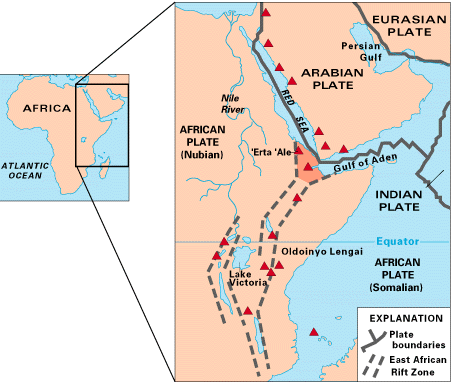
In addition to the rift valley, Sub-Saharan Africa contains a number of highland and plateau regions as well as large, tropical basins, the largest of which is the Congo Basin. This basin begins in the highlands of the rift valley and is the drainage area for the Congo River, Africa’s largest river by discharge and the deepest river in the world. This watershed is considered a biodiversity hotspot and its forests support around 40 million people. However, there is serious concern in the region regarding deforestation.
Africa’s other major river, the Nile, flows from Lake Victoria in the rift valley north through 11 different countries. It is regarded by most as the longest river in the world. The Nile has, historically and in modern times, been a key way to transport people and goods throughout the region and its floodplain enables farming in an otherwise arid environment.
Perhaps the largest ecoregion of Sub-Saharan Africa is the Sahel, located just south of the Sahara (see Figure 6.4). The Sahel is a transitional region connecting the dry Sahara to the tropical regions of the south. It is mostly grassland and has traditionally supported semi-nomadic livestock herders.

The Sahel is at the front line of one of the most pressing environmental concerns in Africa: desertification (see Figure 6.5). Desertification refers to the process of previously fertile land becoming desert and occurs for a variety of reasons including climate change and human activities. Overgrazing, for example, can rid land of vegetation causing the erosion of fertile topsoil. Warming temperatures due to global changes in climate can change precipitation patterns and increase the speed of evaporation. Desertification in the Sahel has caused the Sahara to expand and has led to conflict as northern farmers have migrated to the south in search of fertile soil.
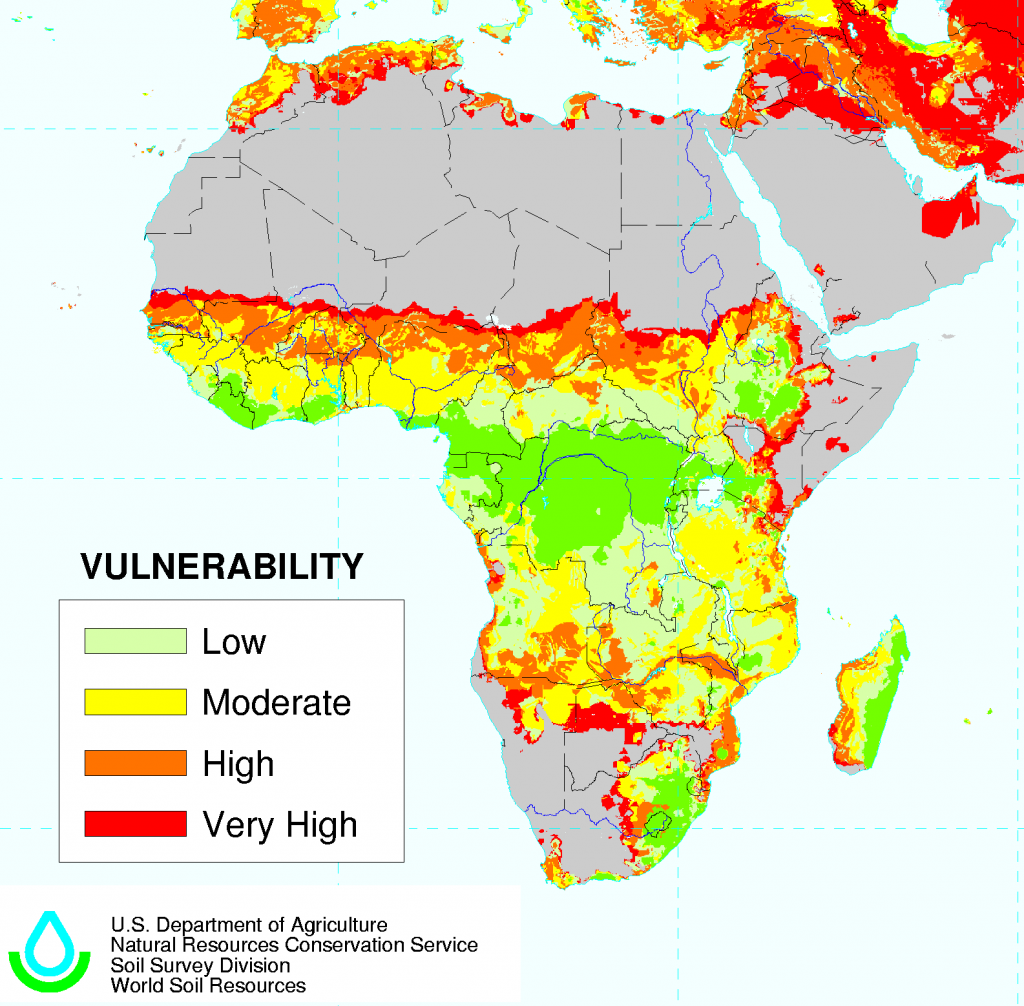
In addition to an array of landforms from rift valleys to mountains to deserts, Sub-Saharan Africa contains a wide variety of climate zones and precipitation patterns. In general, the continent is relatively hot with temperate climates in the higher elevations. Some areas of Sub-Saharan Africa, particularly the tropical rainforests of West Africa, receive upwards of 3,000 mm (118 inches) of rain each year, while other areas such as the Namib Desert receive less than 10 mm (0.39 inches) of rain annually.
6.2 Pre-Colonial Sub-Saharan Africa
Africa has a long history of human habitation giving rise to numerous cultural and linguistic groups. Early humans were primarily gatherers, and there is evidence of people gathering nuts, grasses, and tubers around 16,000 BCE in the highlands of Northern Ethiopia. Around 10,000 years ago, the domestication of the first crops and livestock developed in Africa and the practice of settled agriculture began.
In pre-colonial Africa, women were, and still are in many areas, the primary agriculturalists. It was the responsibility of women to understand the seasonality of crops and this, along with the role of bearing and rearing children, gave women an important role in African society. Many early religions placed a strong emphasis on female goddesses reflecting the central role of women in society. Men were primarily the hunters and gatherers.
For early Africans, the family was the basic and most important social unit. It was the family unit that owned and accessed land rather than individuals. Furthermore, land could not be bought or sold, but instead was passed down through the tradition of partible inheritance, meaning land is divided among the heirs. Elsewhere in the world, such as in the United Kingdom for much of its history, land was passed down to the firstborn male, known as primogeniture. With partible inheritance, however, no landed aristocracy developed since every male was given an equal share rather than just the firstborn.
If the family was the basic social unit in African society, it was the extended family that was the most important politically. Tribes, consisting of groups of families united by a common ancestry and language, controlled distinct tracts of territory. In pre-colonial Africa, there were over 800 distinct ethnic regions – and some of the ethnic regions identified by anthropologists actually had multiple distinct cultural groups within them (see Figure 6.6). Tribal groups sometimes coexisted peacefully, and other times, warred over territory.
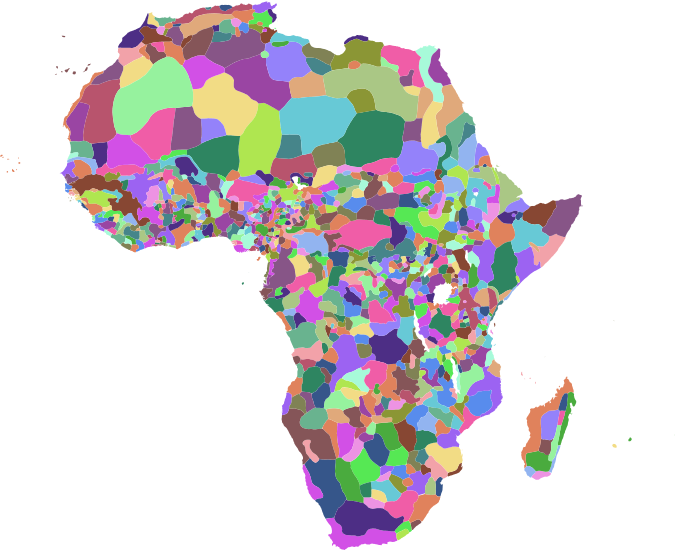
Pre-colonial Africa was also the site of a number of large empires (see Figure 6.7). The Kingdom of Kush, for example, was established in 1070 BCE and located on the Nile River just south of the Egyptian Empire. The Kingdom of Aksum located in present-day Eritrea and Ethiopia existed from 100 CE to 940 CE and was one of the most powerful of the pre-colonial African empires. The rulers of the kingdom minted their own currency, built religious monuments, and established trading routes. The first state in West Africa was the Empire of Ghana, which lasted from around 350 CE until its conquest by the Mali Empire in the 1200s CE. The Empire of Ghana had a large capital city, markets, and a system of taxation.

Two historical events brought significant change to Africa’s cultural landscape and history. The first was the spread of the Islamic Empire across North Africa beginning in the 7th century CE. The second was the start of the transatlantic slave trade in the 15th century CE. Slavery was present in Africa long before European conquest, however. In some pre-colonial African societies, as in other parts of the world, slavery was a part of the local community. Slaves might be taken from conquered groups or given as gifts. In general, though, slavery represented a relatively small segment of ancient African society and economy.
European contact with Africa was initially focused on establishing a port along the West African coast, a place to resupply along the long trip to South and Southeast Asia. Beginning in the 15th century, however, this objective shifted to gaining resources. Portugal was the first of the Europeans to begin buying enslaved Africans. The Portuguese, originally interested in trading for gold and spices, set up several sugar plantations on the islands of São Tomé, off the western coast of Equatorial Africa. Portugal then brought in slaves to help cultivate the sugar. The Spanish then began buying slaves to send to the New World in the early 16th century, bringing them first to the islands of Cuba and Hispaniola. Initially, Europeans raided coastal African villages in order to secure slaves, but over time, began purchasing slaves from African rulers and traders.
Since pre-colonial Africa was divided into distinct ethnolinguistic regions, Africans generally saw themselves as part of their ethnic group or tribe rather than as united by a “black” or “African” identity. Thus, the slaves sold by Africans were seen as “other,” something different or less than themselves. Europeans developed military alliances and beneficial trading partnerships with some of these groups to ensure a steady supply of slaves. By 1700 CE, around 50,000 slaves were being shipped out of Africa each year, and though it is difficult to know the exact total number of people sold into slavery, it is estimated that around 12 million Africans were shipped to the New World.
During this time, many African groups practiced a form of agriculture known as shifting cultivation, where one area of land is farmed for a period of time and then abandoned until its fertility naturally restores. Eventually, farmers return to the abandoned plot of land after many years, which is now overgrown, and often burn the vegetation, known as slash-and-burn, in order to return the nutrients to the soil. Because of this, much of the land in Africa looked unused, but was actually part of a larger agricultural system. Colonial empires took over these fragments of unused land to set up their own agricultural systems.
For some time, European empires had this relatively piecemeal approach to Africa, taking resources, land, and slaves without directly controlling territory. Europeans had little interest in the interior of Africa and were primarily focused on the coastal areas. This would completely change beginning in the late 19th century as European powers scrambled for control of the continent.
6.3 Sub-Saharan African Colonization
As the Industrial Revolution was spreading across Europe, colonial empires were seeking to expand their colonial holdings in order to gain mineral resources and expand agricultural production. As Europeans began exploring the interior of Africa, and recognized its resource potential, competition among European empires grew fierce. France, Italy, Britain, Portugal, and Belgium all raced through the interior of Africa trying to expand and strengthen their territories. When Germany entered the race, the colonial empires decided that it was in Europe’s best interest to agree on and clearly demarcate African colonies and to agree on common policy.
In 1884, 13 European countries as well as the United States sent representatives to the Berlin Conference. At this conference, the colonial powers established the procedure for a Western country to formally control African territory and ultimately re-shaped the map of Africa. In a continent that had previously been divided into territories held by tribal groups and some larger kingdoms, the political boundaries were completely changed. By the early 20th century, around 90 percent of Africa was directly controlled by Europeans (see Figure 6.8).
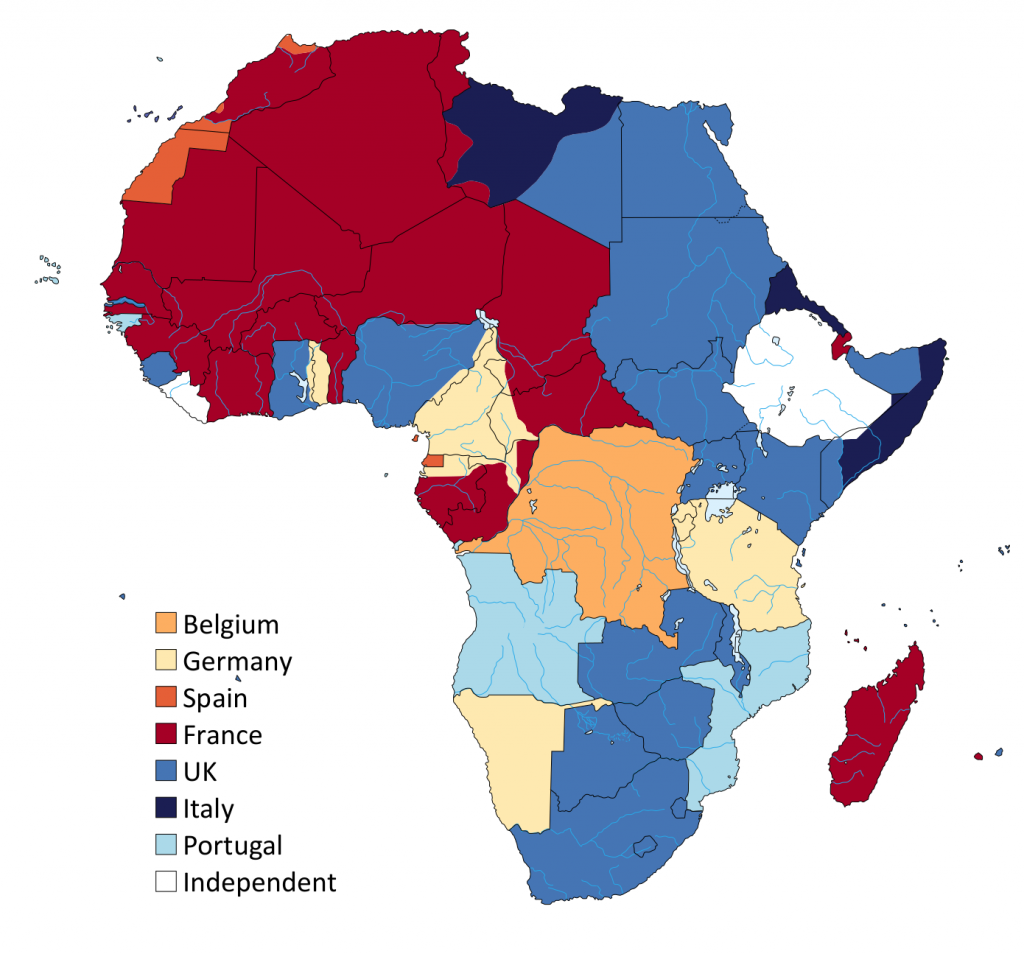
European colonization of Africa completely reshaped the political and ethnic landscape, with lasting effects even today. Colonialism broadly refers to the control of a territory by another group and colonial policies varied across Africa. In the Belgian Congo, what is now the Democratic Republic of the Congo, there was a racist ideology of paternalism where Africans were essentially viewed as children needing a fatherly, or paternal, authority to educate them in the ways of the West. In the far-reaching French colonies, from present-day Madagascar to Morocco, the colonizers emphasized an assimilationist policy, spreading the French culture through language, laws, and education. In the British colonies, like present-day Uganda, Ghana, and Nigeria, settlers partnered with local rulers who were made representatives of the British crown. This was known as indirect rule. The Portuguese, however, continued to be primarily interested in resources rather than local politics or culture. Their policy of exploitation in places like Angola and Mozambique ignored local development and the empire kept rigid control over local economies.
European colonizers were generally focused on exporting goods, with little attention given to local development or connectivity. These easily sold raw materials or agricultural goods are known as commodities. Local communities which may have previously practiced subsistence agriculture were shifted to export-oriented crops destined for European markets. When rail lines were built in Africa, they were generally constructed to simply take resources from the interior to the coastal ports without concern for developing regional linkages.
Eventually, the African colonies gained their independence, though the ease with which they were granted independence and the ease of their transition varied widely. Because the British practiced indirect rule, their colonies generally had a gradual transition of power with local rulers who’d been made representatives of Britain now governing over independent territories. Belgium, however, initially opposed the independence movement in its colonies, which were ruled directly by Belgian leaders. Most African countries would gain their independence following World War II. The last European colony to be granted independence was Djibouti in 1977.
While independence movements successfully broke territories free from European control, many areas were faced with a difficult decision regarding how to politically organize as a state. The European powers had redrawn the map of Africa with no regard for underlying ethnic territories. Some ethnic groups were thus grouped together, sharing colonial territory with groups they had long-standing conflicts with. Other ethnic groups were split apart, divided between two or more colonies. As the new political map of Africa took shape, it generally followed many of the colonial boundaries that had been artificially created.
Where two or more ethnic groups shared a newly independent territory, how should they decide who should rule? Perhaps the groups could simply share power and live peacefully. But what if one group, because of imposed colonial boundaries, no longer had access to resources? What if another group wanted to have unilateral control and not share it with groups they perceived as “other”? Many of the political and economic challenges facing the countries in contemporary Africa are rooted in its colonial history.
6.4 The Modern Sub-Saharan African Landscape
Today, Sub-Saharan Africa is comprised of 48 independent countries and is home to 800 million people. While colonialism transformed African politics and economics, the way of life for many Africans has changed relatively little. Only around one-third of people in Sub-Saharan Africans live in cities, and as of 2007, 72 percent of these city-dwellers lived in slums. Sub-Saharan Africa is still largely rural. Urbanization is increasing, however, as governments have invested in industries in an effort to strengthen economic development drawing impoverished farmers from rural communities. Relatively few Sub-Saharan Africans live in large cities; most live in urban areas with fewer than 200,000 people. A notable exception to this is Nigeria, which was 48 percent urbanized in 2015 and contains several cities with over one million residents including its former capital Lagos (see Figure 6.9). The metropolitan area of Lagos has a population estimated to be 21 million; it is the most populous city in Africa.

Sub-Saharan Africa’s population has been climbing rapidly with the highest fertility rates of any region in the world. In Angola, for example, on the southwest African coast, most women have around six children. This has created a very high dependency ratio across the region, referring to the ratio of people not in the labor force to the number of productive workers. Africa’s population is expected to double between 2010 and 2050. Nigeria, with 2017 population of over 190 million, is projected to surpass the population of the United States by 2050 to become the third-most populous country in the world.
In addition to rapid population growth, another significant challenge facing the governments of Sub-Saharan Africa is related to healthcare. Across the region, imbalances exist between the availability and quality of care. Furthermore, Sub-Saharan Africa’s tropical climate has contributed to the spread of a number of serious illnesses, and this fact, combined with often ineffective or under-funded post-colonial governments have made stopping the spread of disease difficult. In some areas, western aid workers have been viewed with suspicion by Africans fearful of western intervention given their colonial histories. In other countries, foreign aid meant to help the poorest in the region has instead financed corrupt governments and military spending.
There are a number of illnesses, like hepatitis and hookworm, that are endemic to Sub-Saharan Africa, meaning they are found within a population in relatively steady numbers. Before a vaccine was developed, chicken pox was endemic in the United States, existing in a relative state of equilibrium. When a disease outbreak occurs, it is known as an epidemic. Epidemic diseases often affect large numbers of people on a regional scale. The flu in the United States is an example of an epidemic disease, with increasing numbers of people affected during the winter months.
Malaria, a disease spread by mosquitos, is the deadliest disease in Sub-Saharan Africa and sudden epidemics can affect large populations. If left without proper treatment, the disease can also reemerge months later. 90 percent of all deaths from malaria worldwide occur in Africa and it is estimated that the disease costs $12 billion each year due to increased healthcare cost, lost economic productivity, and a negative impact on tourism. Other insect-borne diseases that have a significant clustering in Africa include Yellow fever, which is also spread by mosquitoes, and trypanosomiasis, better known as sleeping sickness, which is transmitted by the bite of the tsetse fly.
When examining the geography of the global HIV/AIDS epidemic, Sub-Saharan Africa clearly stands out (see Figure 6.10). Around 70 percent of all people living with HIV/AIDS live in Sub-Saharan Africa and while a diagnosis with the disease might be met with long-term treatments in other regions, its fatality rate in Sub-Saharan Africa is much higher. In the hardest-hit countries, like Swaziland, Botswana, and Lesotho, more than one in five adults are infected. The disease is most often spread here by unsafe sexual practices, such as having sex unprotected with multiple partners even after marriage. Older adults in Africa are also deeply affected by HIV/AIDS, as they are often left to care for grandchildren orphaned by the disease. HIV/AIDS remains the leading cause of death in Africa.
Still, there have been strides to try to slow the spread and assist those with the disease. Countries like Uganda have supported public awareness campaigns promoting monogamy in marriage and contraceptive use. They were able to slow the prevalence of HIV infections from 15 percent in the early 1990s to just 5 percent in 2001. In recent years, however, the infection rate in Uganda has once again climbed. Some say the government squandered aid money from the international community and did not keep up the public health initiative once rates decreased ultimately causing the infection rates to rise. There is also a concern that religious initiatives promoting abstinence have not had the desired effect. In a 2011 survey, around one-quarter of married men in Uganda reported having multiple sexual partners in the past year and just eight percent of them reported using a condom.
Periodically, regions in Africa, particularly West Africa, have experienced epidemics of Ebola, a viral hemorrhagic fever. Although Ebola is relatively difficult to transmit from person-to-person – it cannot be spread through the air like the flu – a combination of lack of understanding about disease transmission, inadequate infrastructure, and a distrust of Western intervention has made the region particularly vulnerable to deadly outbreaks. An outbreak beginning in 2013 in the coastal West African country of Guinea spread across the surrounding area and killed 11,000 people over the course of two years (see Figure 6.11).
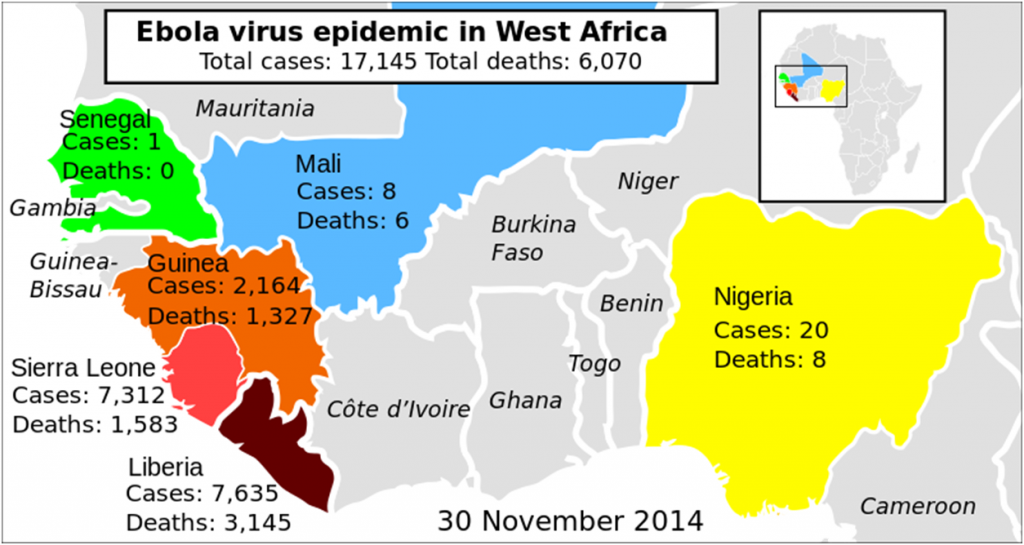
The political issues and difficulties of dealing with Africa’s healthcare crises illustrate larger issues related to governance in the region. Corruption is a significant problem across Africa costing residents around $150 billion each year. Bribery, even to access some public services, is common in many areas. Several governments deteriorated to the point where they are no longer functional, which is referred to as a failed state. In fact, of the ten states most vulnerable to failure in the world, seven are located in Africa.
In some areas, political conflict has gone hand-in-hand with ethnic conflict. Where competing ethnic groups found themselves sharing the same territory after independence, civil wars sometimes erupted as one group vied for power. Some groups turned to genocide, the systematic elimination of a group of people, in order to gain territorial and political control. In Rwanda, which had been a Belgian colony following Germany’s defeat in World War I, the Belgian colonizers had given political power to the minority Tutsi. The Belgians perceived the Tutsi as closer to Caucasian, and this policy of granting power to minorities was a global colonial strategy aimed at suppressing the majority ethnic group.
After Rwanda gained independence in 1962 CE, the Hutu, who represented around 85 percent of the population, came to power and violent conflict between the Hutu and the Tutsi began almost immediately. Hundreds of thousands of Tutsi fled, becoming refugees, people who have been forced to leave their country. By the early 1990s, the Hutu began preparing for genocide, seeking to eliminate the Tutsi minority. Over the course of 100 days between April and July 1994, 800,000 Tutsis were killed – around 50 percent of the entire Tutsi population. By the time the United Nations admitted that “acts of genocide may have been committed,” 500,000 had already been killed, most murdered with machetes. Rape was also systematically used against the Tutsi women. The Rwandan Patriotic Front, formed by exiled Tutsi refugees, defeated the government’s forces and has governed Rwanda since the end of the genocide. Conflict between Tutsi and Hutu, particularly in neighboring Burundi, has continued, however.
In South Africa, the ruling party that came to power after independence was dominated not by an indigenous African group but by the descendants of Dutch settlers, known as Afrikaners. Africans in South Africa outnumbered non-Africans by 4 to 1 and the ruling Afrikaners instituted a policy of racial separation known as apartheid aimed at maintaining minority rule. This system of segregation led to an entirely different system of education for non-white South Africans, limited their use of public spaces, and forced the relocation of millions into separate neighborhoods. The system ended in 1994 with the country’s first democratic elections, but inequality between white and non-white Africans persists, and has actually worsened according to some measures.
Some countries have tried to overcome political instability and the lack of colonial connectivity by creating interregional organizations aimed at economic and political cooperation. The largest of these organizations is the African Union, which formed in 2001 and consists of every African state, including Morocco which recently rejoined the AU in 2017. Among other objectives, the African Union seeks unity, integration, and sustainable development. Other regional organizations exist with narrower objectives, such as the Economic Community of West African States (ECOWAS) and the Common Market for Eastern and Southern Africa (COMESA), both of which aim to create free trade areas between member countries. Because of the diverse array of Africa’s cultural and linguistic groups, organizations have often found it helpful to have a lingua franca, a common language spoken between speakers of different languages. In some cases, the lingua franca is the language of a common colonizer, such as English or French. In other cases, the language is native the region, such as with Swahili, the lingua franca for much of Southeast Africa.
6.5 Economics and Globalization in Sub-Saharan Africa
Although formal colonization of Africa ended by 1980, in many areas, it was replaced with neocolonialism, the practice of exerting economic rather than direct political control over territory. During the colonial era, European groups formally controlled Africa’s resources and created export-oriented economies. Today, most of Sub-Saharan Africa’s exports remain raw materials. This makes the economies of countries in the region vulnerable to price fluctuations and global markets. Furthermore, although Western countries no longer directly control African land, corporations based in these countries have either bought land directly or invested heavily in the region. Investors have also purchased the water rights to some areas.
Neocolonialism is also evidenced on a broader scale. The peripheral regions of the world generally supply goods and labor used by the core countries. Thus, the core continues to exert economic pressure on the periphery to maintain beneficial trade partnerships and cheap products, labor, and raw materials. In many countries, particularly in Sub-Saharan Africa, a dual economy exists, where plantations or commercial agriculture is practiced alongside traditional agricultural methods. South Africa’s dual economy, for example, has created dramatic differences in development within its own borders and has exacerbated income inequality in the country. Critics of neocolonial theory argue that too much blame is placed on colonialism for the modern economic problems in Sub-Saharan Africa. Indeed, government corruption, inefficiency, and internal exploitation remains a significant barrier to long-term economic development.
In some cases, economic pressure has come from loans granted by the core to the periphery. Although the intention of these loans was to assist the periphery in infrastructure development, many countries have struggled under the weight of staggering debt. Two lending organizations in particular, the International Monetary Fund (IMF) and World Bank, have loaned over $150 billion to countries in Africa. Loans by the IMF and World Bank to countries experiencing economic crises are accompanied by structural adjustment programs (SAPs), stipulating economic changes a country must make in order to make it better able to repay its loans. These conditions might include decreasing wages, raising food prices, or making the economy more market oriented.
In practice, though, structural adjustment programs limit the ability of states to make their own economic decisions, which some see as neocolonialism. In addition, SAPs require governments to drastically cut their spending which most often leads to cuts in social services and public health. These austerity measures can lead to economic stagnation, ultimately hampering a country’s ability to pay back its loans – the very thing the SAPs were designed to do. Furthermore, aid packages and loan programs were generally designed to reflectWestern ideas of development. This could be viewed as further evidence of neocolonialism in the region.
For some countries, the interest payments alone far exceed what they are able to pay. Globally, 39 countries, 33 of which are in Sub-Saharan Africa, have been identified as heavily indebted poor countries and eligible for debt relief through a joint venture by IMF and World Bank. Changes have been made to the program to specifically address poverty in these countries and shift the loan payment amounts to funding for social and public services.
Increasingly, African countries are partnering with investment groups rather than lending organizations and private investment now exceeds development assistance. China is Africa’s largest trading partner and the country has invested billions in African infrastructure projects and direct aid. Chinese investment projects include a $12 billion coastal railway in Nigeria and a $7 billion “mini city” in South Africa. In Angola, Chinese investors built Kilamba New City, a town complete with 25,000 homes, schools, and commercial facilities, to be repaid by Angolan oil (see Figure 6.12).

For low-income individuals in Sub-Saharan Africa, microfinance has provided a way to access a range of financial and investment services. These services might include small loans, known as microcredit. Women in particular have benefitted from microcredit, which does not require complex paperwork, extensive employment history, or collateral as with traditional loans, but has provided a way for women to become entrepreneurs. Interest rates on these loans is generally quite small, and over 95 percent of loans are repaid. Globally, microcredit loans totaled $38 billion in 2009. Globally, most of the 150 million microfinance clients are in Asia, but microfinance in Africa is growing.
Sub-Saharan Africa is one of the fastest developing regions in the world with a 4 percent growth rate in 2016 compared to a global average of 3.4 percent (see Figure 6.13). Much of Africa’s economic growth has resulted from trade, and the region is rich in resources and has a large labor pool. However, despite significant mineral, agricultural, and energy resources, most people in the region remain impoverished. Africa’s leading export, for example, is petroleum and petroleum products, and yet most Africans do not have access to a reliable source of electricity. Political instability, too, has limited the benefit of economic growth for many low-income Africans. Economic growth, if invested in infrastructure and public services, combined with increased educational and career training opportunities could improve incomes in the region. According to current estimates, by the end of this century, Africa’s population will quadruple. This rapid population growth coupled with continued economic development could dramatically reshape the African geographic landscape.

a protruding peninsula in East Africa that contains the countries of Djibouti, Eritrea, Ethiopia, and Somalia
a transitional region in northern Africa connecting the dry Sahara Desert to the tropical regions of the south
the process of previously fertile land becoming desert
a group of families united by a common ancestry and language
a system of agriculture where one area of land is farmed for a period of time and then abandoned until its fertility naturally restores
the control of a territory by another group
raw materials or agricultural goods that are easily bought and sold
a disease found within a population in relatively steady numbers
a disease outbreak
when a government deteriorates to the point where it is no longer functional
the systematic elimination of a group of people
people who have been forced to leave their country
the ruling Dutch government’s policy of racial separation in South Africa
an interregional organization in Africa that seeks unity, integration, and sustainable development
a common language spoken between speakers of different languages
the practice of exerting economic rather than direct political control over territory
a region of islands to the northeast of Australia that include Papua New Guinea and Fiji
a set of required economic changes that accompany a loan made by the International Monetary Fund and the World Bank to country that is experiencing an economic crisis
financial and investment services for individuals and small business who otherwise do not have access to traditional banking services

